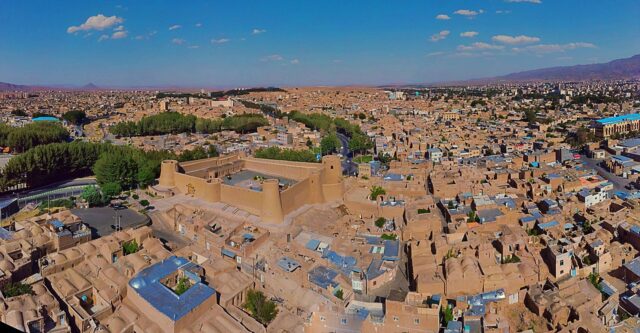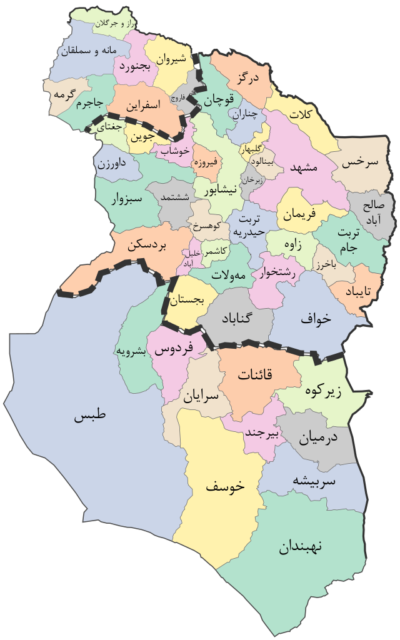
Persian Files ISSN 2975-0598 Volume 16 Issue 4
Author: Silvia Boltuc
The strategic positioning of the Khorasan region is pivotal for the facilitation of trade and cultural interchange with adjacent nations. In this regard, implementing Special Economic Zones (SEZs) might strengthen the relations between Afghanistan and Iran.
If, on the one hand, there are opportunities which might increase trade and cooperation between Iranian and Afghan companies, on the other hand, the Taliban’s rule in Kabul and logistical obstacles present significant challenges that necessitate a nuanced approach.
This report aims to investigate Khorasan’s strategic location since the region shares borders with Afghanistan and Central Asia, making it a vital gateway for trade and cultural exchange between Iran and its neighbours.
This study will assess the potentialities of the region, especially after Tehran established SEZs, as well as challenges for a further improvement of trade and business cooperation between the Islamic Republic of Iran and the Islamic Emirate of Afghanistan.
Iran Free Economic Zones and Tehran-Kabul’s Trade Opportunities:
Background Information
South Khorasan has 1.700 industrial units and is known for its agricultural and mining activities. The province is a major producer of saffron, pistachios, and other agricultural products. It also has significant mineral resources, including copper and precious stones. The capital, Birjand, has historically been part of the Silk Road.
Afghanistan sources over 92% of its imports from neighbouring countries, and Iran has become its primary trading partner.
On September 11th, 2023, Iran’s trade advisor in Afghanistan reported that the current import portfolio, valued at approximately 6 million dollars, predominantly encompasses items related to food and agricultural processing industries, various fuels (including diesel, gasoline, liquefied gas, and hydrocarbons), essential commodities such as flour, wheat, sugar, edible oil, plastic products, confectioneries (sweets and chocolate), tomato paste, eggs, vegetables, citrus fruits, ceramic tiles, pharmaceuticals, medical equipment, valves, construction pipes, fittings, and building materials like cement and iron.
The Iranian representative underscores that Kabul’s primary focus is on importing essential goods necessary for the well-being of its population. This emphasis presents a significant opportunity for the three Khorasan provinces (South Khorasan, Razavi Khorasan, and North Khorasan) to augment their exports to Afghanistan.
This strategic trade relationship not only highlights Iran’s role as a crucial supplier of vital goods to Afghanistan, but also underscores the potential for economic cooperation and growth, particularly in cross-border trade and regional economic dynamics.
In August 2021, the Taliban assumed control of Afghanistan, resulting in the country’s continued international isolation. Despite these challenges, noteworthy progress has been made in several key areas, notably in enhancing security, promoting transparency, and establishing fixed tariff rates to facilitate trade between Iran and Afghanistan.
The Iranian Ministry of Commerce has reported a notable uptick in exports under the Islamic Emirate’s administration. Specifically, Iran routes over 45 per cent of Afghanistan’s transit trade, with the Dugharun border in Razavi Khorasan and Mahirud border in South Khorasan playing pivotal roles.
Additionally, there is a growing emphasis on leveraging the potential of the Chabahar Free Zone, which is exempt from international sanctions and attracts numerous investors, thereby bolstering trade interactions between Iran and Afghanistan.
An important development is the recent approval of the Dogharoun Free Trade Zone in the Islamic Consultative Assembly in August 2023. This approval is expected to have a positive impact on strengthening future trade relations between the two countries.
Moreover, Tehran is actively pursuing the establishment of a joint trade zone between Iran and Afghanistan. It’s worth noting that the commercial centre of Iran in Kabul has been somewhat overlooked in recent times. Nevertheless, expectations are high that the three eastern provinces of Iran will establish large export holdings in this centre.

South Khorasan province (Credits: 4nn1l2derivative work: 4nn1l2, CC BY-SA 4.0, via Wikimedia Commons)
Iranian Khorasan: a Geopolitical Scenario
Khorasan boasts a rich historical and cultural legacy, featuring many archaeological sites and monuments, notably the ancient centre of Nishapur, which flourished during the Islamic Golden Age and serves as the final resting place for renowned Persian poets Omar Khayyam and Attar.
Khorasan’s historical sites, natural beauty, and cultural attractions, including the extreme Lut Desert, draw global tourists, while its cultural diversity with Persians, Baluchis, and Afghan refugees enriches the region, and its religious significance is exemplified by Mashhad’s Imam Reza Shrine, a major Shia pilgrimage site.
The vast Khorasan province sits on massive God-given reserves like iron ore mines, natural gas and coal. Aligned with Iran’s economic policy aiming for industrial self-sufficiency and reducing dependence on crucial imports, Khorasan hosts key industries, such as the Khorasan Steel Complex (KSC).
The province is also known for its agricultural industry: key agricultural products from the Iranian Khorasan include saffron, pistachios, and various cereals like wheat and barley. Considering its extensive experience in the agricultural domain, Iran is contemplating providing assistance to Afghanistan in the development of this sector, which remained underdeveloped.
80 per cent of employment relies on agriculture, and over 40 per cent of total Afghan exports are agricultural. In this light, the Iranian trade advisor in Afghanistan emphasised the need for South Khorasan, Razavi, and North Khorasan provinces to impart modern irrigation and mechanisation techniques to Afghan farmers through workshops and exhibitions. Iran might also provide electricity to develop Afghan rural areas, as Khorasan can provide renewable energy.
Still, there are some issues which need to be addressed, like the lack of joint companies in the field of logistics and road transportation between the two countries.
Given Khorasan’s proximity to Afghanistan, this region is important for Iran’s border security efforts. It plays a role in controlling the movement of goods and people across these borders and addressing security challenges, especially considering regional instability.
The presence of various ethnic groups in the region, such as Baluchis and Afghan refugees, brings moreover challenges related to cultural diversity and integration, as well as the provision of services to these communities. Another threat to the region is, particularly in the eastern areas, it being susceptible to desertification and water scarcity, which can affect agriculture and livelihoods.
From an economic standpoint, the region possesses abundant resources, encompassing minerals and agricultural products, yet it confronts challenges in effectively harnessing these resources to foster economic growth.
Addressing this necessitates substantial investments in infrastructure development, which can unlock the full economic potential of the region. In this context, the recently established SEZs present a promising avenue for investment, facilitating the development of collaborative projects.
Conclusion
Focusing on the relationship with Afghanistan, it is evident that one of the foremost challenges confronting Iran is the question of the legitimacy of Taliban rule. This issue is intertwined with the broader context of the instability prevailing within the Islamic Emirate and the territorial control exerted by the Taliban in areas proximate to the Iran-Afghanistan border.
Such circumstances introduce a series of security challenges, notably the potential for cross-border militancy, drug trafficking, and assorted security threats. Notably, Afghanistan stands as a significant producer of opium and illicit narcotics, and the Taliban’s administration over regions associated with drug production can exacerbate the prevailing narcotics trade.
Further compounding the complexity of Iran’s relations with the Taliban are ideological disparities, particularly regarding matters pertaining to women’s rights and religious interpretations. Iran has articulated its concerns regarding the welfare and rights of Afghan women and minority communities under Taliban rule.
The reintegration of Afghan refugees into their homeland and the looming prospect of an influx of new refugees due to the deteriorating security situation represent additional areas of apprehension for Tehran. These challenges entail substantial demands on Iran’s resources and infrastructure. Furthermore, Tehran recognises that disruptions in trade routes and economic ties with Afghanistan, particularly in the event of sanctions, can have adverse implications for its own economy, exemplified by the prior impact on the Chabahar port project.
The multifaceted nature of these challenges necessitates that Iran adopts a pragmatic approach to its dealings with the Taliban while simultaneously weighing its interests and relationships with other Afghan factions.
Iran’s historical, cultural, and ethnic affinities with specific Afghan groups, such as the Hazaras, add a layer of significance to the Taliban’s treatment of these groups and its potential repercussions for Iran’s relations with the Islamic Emirate.
Effectively navigating these intricate dynamics demands a nuanced strategy from Iran, encompassing diplomatic initiatives, astute border management, and humanitarian endeavours. Tehran may opt to engage constructively with the Taliban while vigilantly safeguarding its interests and regional stability.
Over the years, Tehran has consistently extended humanitarian assistance to Afghanistan, with a dual aim of regional stabilisation and averting mass migrations toward the Islamic Republic of Iran. It is undeniable that the evolving circumstances in Afghanistan will continue to exert a profound influence on the multifaceted tapestry of Iran-Afghanistan relations.
Do you like SpecialEurasia reports and analyses? Has our groundbreaking research empowered you or your team? Now is your chance to be a part of our mission! Join us in advancing independent reporting and unlocking the secrets of Eurasia’s complex geopolitical landscape. Whether through a one-time contribution or a monthly/yearly donation, your support will fuel our relentless pursuit of knowledge and understanding. Together, let’s pave the way for a brighter future. DONATE NOW and secure your place in shaping the geopolitical narrative.
